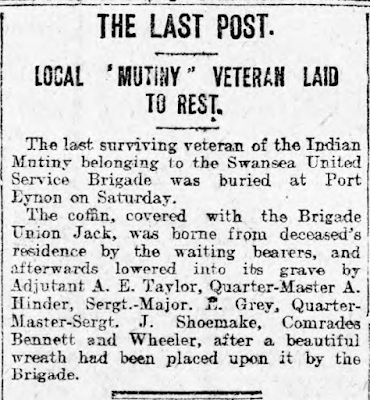Mystery at Port Eynon
 |
| Indian Mutiny, 1857-58 1912 Map - showing the centres of the rebellion |
The rebellion erupted into other mutinies around Northern and Central India. The rebellion posed a considerably threat to the British power in the region.
During the Mutiny there were a series of conflict, including, Siege of Delhi, 1857; Siege of Cawnpore, 1857; Siege of Lucknow, 1857 and Siege of Arrah, 1857. These are well known conflicts, also there was the Central Indian Campaign, 1858.
The result of the Indian Mutiny, at conclusion, was a British victory, with the creation of the British Raj, from the former East Indian Company. Lands were either returned back to their former owners, or confiscated by the British Crown.
 |
| The Cambria Daily Leader 7th December 1914 |
On that winters day, 1914, the last veteran of the Indian Mutiny was buried at St. Cattwg's, Port Eynon. He belonged to the Swansea United Service Brigade.
 |
| St. Cattwg's Church, Port Eynon, Gower |
The south wall was added during the 14th - 15th centuries. Restorations were carried out at the expense of C.R.M. Talbot, during 1876. Further restorations were carried out during 1905 at the expense of Miss Emily Talbot. £200 were paid towards restorations during the 1920s.
 |
| Port Eynon Lifeboat crew Memorial St. Cattwg's Church, Port Eynon, Gower |
 |
| Port Eynon Lifeboat crew Memorial Inscription |
It is in the churchyard, that there is a memorial commemorating to the three crew members of the Port Eynon lifeboat who lost their lives 1st January 1916.
Steamer Dunvegan, having losing power, near Oxwich via a westerly gale. The ship's captain, later, requested a tug to tow them into the port of Swansea, and not a lifeboat.
 |
| Janet lifeboat |
The Janet, finally reached Mumbles, 23 hours after it was lunched, with the remainder of the 10 crew. The crew that were missing were:
 |
| William Gibbs |
William Eynon, 46, Second Coxswain. His body was washed ashore at Porthcawl later and he was buried at St. Cattwg's
George Harry, 46, Lifeboatman. His body was washed ashore four later at Jersey Marine, where he was buried
 |
| William Eynon St. Cattwg's church, Port Eynon, Gower |
 |
| George Harry Jersey Marine |

Comments
Post a Comment